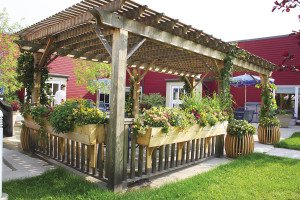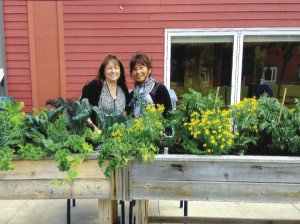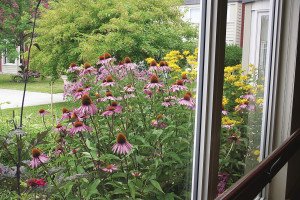
THUNDER BAY—Lynda Lahteenmaa is a master gardener, but the Thunder Bay woman says that for her, gardening is more than the cultivation of the soil.
“Gardening is also about enrichment of the mind and body,” she says, “and reaching out to the community.”
Toward the latter, Lahteenmaa volunteers at Hogarth Riverview Manor in Thunder Bay, where, working with volunteer coordinator Anna Grenier, she and other master gardeners have created a Horitcultural Therapy program for seniors in long-term care.
The facility has an enclosed courtyard which contains raised beds, vertical and container gardens that are elder-friendly. The courtyard is a safe, accessible environment where residents can get outside to walk and relax. The path through the courtyard is a level, gentle loop that comes back to where it started so residents don’t become confused.
The main elderly residents have a range of cognitive illnesses that manifest as dementia. Horticultural Therapy can be used to stimulate their senses, such as sight, sound, smell, touch, hearing and taste. The therapy is tailored to an individual participant’s physical and mental abilities, with the goal of enhancing their quality of life.
The gardening occurs throughout the year. In the spring, the residents help with planting with the guidance of master gardener volunteers. The residents can then follow the growth of the plants through the summer. Lahteenmaa says herbs have the greatest therapeutic value, because the scent can trigger memories.

During the cold months, the gardening changes to indoor activities, such as planting Amaryllis bulbs for January blooms, creating colorful floral arrangements or making seed mosaics. On St. Patrick’s Day, the focus was shamrock plants and Irish music. At Easter, they plant wheat seeds in an eggshell, which upon sprouting becomes the head of a figurine.
“We always show them the finished product so they understand the outcome of a project,” Lahteenmaa says.
The Hogarth Riverview Manor Therapeutic Horticulture program began in 2008. Lahteenmaa and Grenier coordinate a team of master gardeners and staff who run the program. In order for the courtyard garden to be successful, the master gardeners have taught gardening to Hogarth’s staff. They also work with youth who have an opportunity to learn about gardening and helping the elderly.
But it is a mallard duck that best signifies the success of Hogarth’s courtyard garden. Twice, including this spring, she has chosen to nest in one of the container gardens where residents can watch her. Since the hen can only access the garden by flying, she is unable to lead her brood to water. The first time she was ready to leave with her ducklings, she received a human escort through Hogarth to the door and then across an urban landscapes and a busy street to a nearby waterway.

While the Horticultural Therapy program is successful at Hogarth, Lahteenmaa has a loftier goal. She wants to see such therapy available to everyone in long term care. The simple act of caring for plants can powerfully enhance the existence of people who have entered the final stage of their lives.
